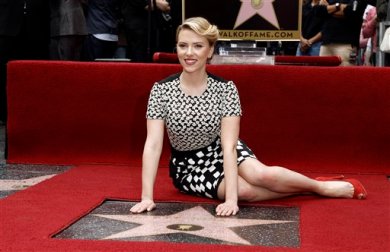
Scarlett Johansson is one of many celebrities accused of fulfilling a role that perpetuates misrepresentation in film. Courtesy of Matt Sayle/AP Images
By Caroline Cane
Even in 2015, when discrimination in film seems to be a problem of the past, there is still controversy over misrepresentation in the film industry with regard to casting.
It seems that recent major movies have represented a plethora of genders, races and sexual orientations. For example, Selma, a film about Martin Luther King Jr., is up for the Best Picture Oscar at the upcoming Academy Awards, as well as The Imitation Game, which features a homosexual protagonist. Nevertheless, the controversy over whether all groups of people are being equally represented remains in film still.
Many believe that transgender people have yet to be fairly represented in films, despite the availability of roles. Last year’s film, Dallas Buyers Club, faced controversy for not only casting Jared Leto, a straight male, to play the role of a transgender woman, but was also criticized after director Jean-Marc Vallee openly told an interviewer from CBC Radio that he did not even consider auditioning transgender actors to play the role, thereby not even giving transgender actors the chance to emerge.
Ghost in the Shell, an upcoming adaptation of a Japanese novel, set to release in 2017, has received attention over the director’s choice to cast Scarlett Johansson as the lead role instead of an Asian-American actress, which many believe is one of many examples of Asian-Americans being overlooked in the film industry. The same casting choice occurred in the adaptation of a Japanese novel, Edge of Tomorrow, in which white actor Tom Cruise portrayed a protagonist who is Asian in the novel, and the character’s name was subsequently changed to one that was more American. This change attracted much attention upon the release of the film.
On the other side of this discussion regarding equal casting is the argument that talented actors should not be limited in the kinds of roles they can play, even if their gender, race or sexual orientation does not match that of the scripted character. Many stand by the opinion that Leto earned his role and his Oscar for Best Supporting Actor last year, and that his identity as a straight male did not prevent him from being able to portray a transgender woman and deliver a moving performance. Likewise, many people would defend Johansson’s acting capabilities, saying that she has proven herself in her past movies such as Lucy and The Avengers and will most likely succeed in Ghost in the Shell.
Robin Andersen, Ph.D, is a professor and director of Graduate Studies in the department of Communications and Media Studies at Fordham University. She was not surprised by these accusations of misrepresentation. “Groups of people, many groups, have not been represented with their full humanity,” she said when asked about her take on whether modern films lack diversity. Andersen also noted how casting decisions are frequently based on the anticipated profit an actor will bring to the film, explaining why these transgender or non-white roles are being played by white actors with high incomes.
The fact that misrepresentation in the film industry is still a topic of discussion even in 2015 is noteworthy, especially since, as seen in Dallas Buyers Club and Ghost in the Shell, there is an availability of roles for all groups of people. However, Hollywood is continuing to recycle the same actors that they know will attract audiences instead of giving new and diverse actors the chance to surface. The casting of films seems to be stuck in a cycle: white, straight actors are the most well-known and are expected to bring in the most profit. Therefore, they are chosen for roles most often, even if it requires the actor to portray a different race, gender or sexuality.
So how can we break this cycle? “The industry just needs to be a lot more sensitive about the people and groups they’re portraying,” says Andersen. “Ultimately, what we’re trying to achieve is media where people have the full complement of humanity that everybody else has.” Although progress has been made, hopefully the New Year will bring new opportunities for films to more accurately portray society as a whole and for this controversy to finally become a thing of the past.
